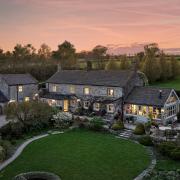Plans are being made to create a perfect woodland vision.’

A garden curator is preparing to realise a new woodland vision for one of the country’s leading botanical gardens. Paul Cook, curator at RHS Harlow Carr in Harrogate is aiming to create a woodland garden with a diversity of plants and wildlife that will create year-round beauty and colour in the 58 acre garden.
‘I want to keep a traditional woodland walk feel but with more open vistas, a lighter, airier atmosphere and more stumble-across glimpses through the trees to pockets of colour and interest that visitors simply have to investigate further,’ said Paul. ‘It’s all about light and space and combining the natural beauty of the Woodland with the changing light through the seasons.’
To achieve his vision, Paul and the garden team at RHS Harlow Carr are removing older, damaged and decaying trees to allow native beech, oaks and other fine trees more space to be appreciated. To encourage wildlife, some of the damaged trees that require felling are left to serve as bat roosts or bird nesting sites. New species have been added to improve the diversity of the woodland area and introduce more striking colour, particularly in the autumn. This includes a selection of maples and liquidambars which will create a riot of colour with rich reds, mellow yellows and burnt oranges.
Visitors to the botanical gardens are urged to seek out some of the rarer trees already thriving in the gardens including Stewartia pseudocamellia, with lovely mottled bark, Clethra delavayi and Cercidiphyllum, whose decaying leaves smell of toffee apples in October. The gardens’ arboretum is the spot to find specimen trees, including collections of conifers, beech (Fagus) and Sorbus. The latter are at their very best in autumn when the leaves redden and the berries shine.

The woodland area is the ideal situation for acid-loving rhododendrons and camellias, whose shallow root systems can so easily dry out in a more open situation, with sometimes fatal consequences. Here they thrive in woodland shade, mulched by the natural leaf fall from the deciduous trees. A programme is in place to renew and propagate some of the older and rarer rhododendron hybrids; there can be a different rhododendron in flower from January until July at Harlow Carr.
Underplanting is a key feature of the new-look woodland: more than 30,000 snowdrops and 30,000 bluebells have been planted en masse, with more to follow, meaning carpets of colour from February through to May. The plan is to create two ‘blue’ corridors: one will run from Southfield, the area just above the Queen Mother’s Lake, through to the former Harrogate Arms, which is due to be redeveloped and brought back into use in the next few years; the other corridor will connect Valley Gardens in Harrogate town centre, through the Pinewoods - in partnership with the Pinewoods Conservation Group – and on into the garden and will feature thousands of native bluebells.
Paul said: ‘I’ve been inspired by some incredible woodland gardens over the years, and want to take the best bits from each and recreate them here at Harlow Carr. Our woodland garden team has made huge strides in the last 18 months to make this vision a reality.’
Visit the Festival of Trees and Wood at Harlow Carr, September 29th-October 1st





























